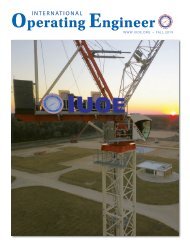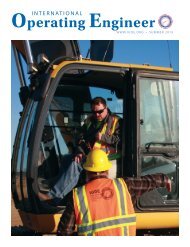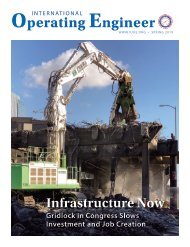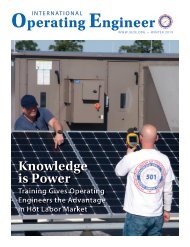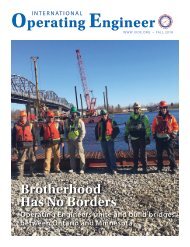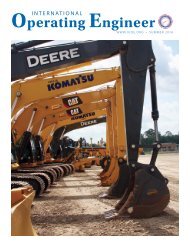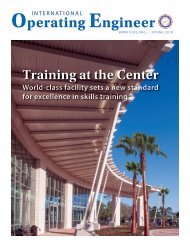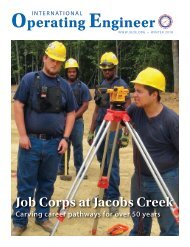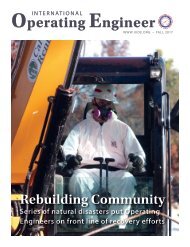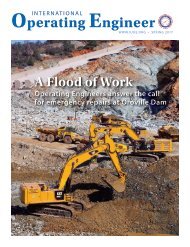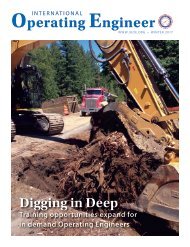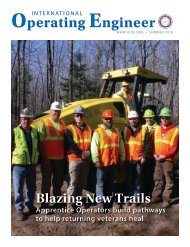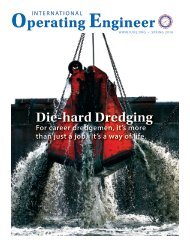125 Years Strong – An IUOE History
Celebrating the 125th Anniversary of the founding of the International Union of Operating Engineers
Celebrating the 125th Anniversary of the founding of the International Union of Operating Engineers
You also want an ePaper? Increase the reach of your titles
YUMPU automatically turns print PDFs into web optimized ePapers that Google loves.
INTERNATIONAL UNION OF OPERATING ENGINEERS<br />
“Namely, to rescue our craft<br />
from the low level to which it has<br />
fallen, and by mutual effort to<br />
endeavor to place ourselves on a<br />
foundation sufficiently strong to<br />
resist further encroachment.”<br />
More-precise motives behind the<br />
establishment of the union are further<br />
provided in The Operating Engineers: The<br />
Economic <strong>History</strong> of a Trade Union written in<br />
1964 by Professor Garth L. Mangum. “The<br />
International Union of Steam Engineers was<br />
formed by the confluence of three groups<br />
of steam engineers,” he wrote. “Those who<br />
became disillusioned with the policies of the<br />
National Association of Stationary Engineers<br />
and organized independent local trade<br />
unions; brewery engineers who withdrew<br />
from the brewery workers union because<br />
they found their problems and interests<br />
distinctive from those of the other brewery<br />
employees; and the hoisting engineers who<br />
found organization of independent local<br />
unions necessary to fit into the well-organized<br />
structure of the building trades.”<br />
To those ends, the 11 engineers from eight<br />
locals in Massachusetts, New York, Ohio,<br />
Illinois, Kansas, Missouri, Michigan and<br />
Colorado who first met on December 7, 1896,<br />
dispatched their three delegates to the A.F.L.<br />
convention in Cincinnati the following week<br />
to petition for a charter. Representing nearly<br />
400 engineers, brothers DeLong, Smales and<br />
Tomsen, joined by Brother Lyon, prepared<br />
the application during their meeting on<br />
December 18 and submitted it to the A.F.L.,<br />
which would grant a charter to the N.U.S.E.<br />
on May 7, 1897.<br />
Although the differences between the three<br />
trades constituting the new engineers’ union<br />
were often greater than their similarities, the<br />
common denominator amongst them was<br />
the steam engine. Hence, the name “National<br />
Union of Steam Engineers” was chosen simply<br />
because steam was practically the only source<br />
of power at that time and was utilized almost<br />
exclusively by all of the union’s membership.<br />
Having officially established the first<br />
representative body of practical steam engineers<br />
in the country, the N.U.S.E. began granting<br />
charters to its local unions. The charter for<br />
Local No. 1 was issued to the Brotherhood<br />
of Steam Engineers of Denver on June 23,<br />
1897, after which the group from St. Louis<br />
was designated Local No. 2; Chicago was<br />
designated Local No. 3 and was the largest with<br />
40 charter members; Boston was designated<br />
Local No. 4 and was the only hoisting and<br />
portable organization; Detroit was designated<br />
Local No. 5; and Kansas City, Missouri, was<br />
designated Local No. 6.<br />
The N.U.S.E. then held that first convention<br />
under the A.F.L. charter on August 9, 10 and<br />
11, 1897, in A. Delabar’s Saloon and Hall<br />
at 504 Market Street in St. Louis. During the<br />
proceedings, the union chose its first elected<br />
officers: Brother Frank Bowker of Boston,<br />
president; Brother Frank Pfohl of Syracuse,<br />
first vice president; Brother Samuel L. Bennett<br />
of Kansas City, second vice president; Brother<br />
C. J. Frealig of Detroit, secretary; and Brother<br />
Smales of Denver, treasurer.<br />
The convention also adopted a Declaration<br />
of Principles, through which delegates<br />
declared that a reduction of hours for a day’s<br />
work “increases the intelligence and happiness<br />
of the laborer” and vowed to secure a higher<br />
standard of wages for its members. With<br />
the proclamation, among other decrees the<br />
delegates also recognized that the “interests<br />
of all classes of labor are identical;” objected<br />
to prison contract labor; urged adoption of a<br />
national, uniform license law for engineers;<br />
pledged to support the A.F.L.; endorsed the<br />
union label; and urged “intelligent voting.”<br />
Before the end of 1897, the first Canadian<br />
locals joined the union, expanding its jurisdiction<br />
across the northern border and prompting the<br />
Members of International Union of Steam Engineers Local No. 66 of Pittsburgh pose during<br />
the city’s Labor Day celebration in 1905, during which they also participated in a parade.<br />
union to change its name to the International<br />
Union of Steam Engineers of America. Shortly<br />
after, however, its General Executive Board<br />
shortened that to the International Union of<br />
Steam Engineers (I.U.S.E.), and on December<br />
17, 1897, at the A.F.L. convention, the union<br />
received permission to officially revise its name.<br />
Initial Trials, Organizing Effort<br />
While the fledgling I.U.S.E. was<br />
firmly established on paper,<br />
throughout its first decade of<br />
existence, the union was little more than a<br />
loose association of a few strong and many<br />
weak self-governing local unions. What’s<br />
more, as The Economic <strong>History</strong> of a Trade<br />
Union points out, from the time of its<br />
founding until 1940, the dual nature of the<br />
organization’s membership, brought together<br />
almost solely by their common utilization<br />
of steam, made it “essentially two unions in<br />
one <strong>–</strong> an organization of stationary engineers<br />
and a building trades union of operating<br />
engineers. In both branches, it was strictly a<br />
craft organization.”<br />
Early on, the union was dominated by its<br />
stationary engineers, who operated immobile<br />
steam engines that produced heat, electric power<br />
and refrigeration in large commercial buildings,<br />
factories and breweries. (1) It also included a<br />
much smaller portable membership of factory<br />
employees, marine engineers, operators at mines<br />
and workers in the building trades <strong>–</strong> although The<br />
Economic <strong>History</strong> of a Trade Union notes, “The<br />
building and construction industry eventually<br />
became its mainstay, though the stationary<br />
engineers remain an important segment of the<br />
union’s membership.”<br />
After President Bowker passed away while<br />
in office on January 1, 1898, and First Vice-<br />
President Pfohl assumed the presidency, the<br />
union began to rapidly grow in membership<br />
and, to some degree, prominence. As of that<br />
date, the I.U.S.E. had a total of 788 members,<br />
with Local 1 thought to be its largest local with<br />
200 members, the July 1902 International Steam<br />
Engineer reported. Less than five years later, by<br />
October 1902 the union consisted of 166 local<br />
unions from coast to coast totaling more than<br />
19,000 members in good standing (that is, any<br />
person who has fulfilled the requirements for<br />
membership in the organization, including<br />
payment of required union dues and fees).<br />
However, the membership growth during<br />
the union’s first half decade was primarily the<br />
result of independent local unions coming<br />
into the international. (1)<br />
The I.U.S.E. made its first earnest attempts<br />
to organize new members and bring existing<br />
LABOR OMNIA VINCIT<br />
WORK CONQUERS ALL



